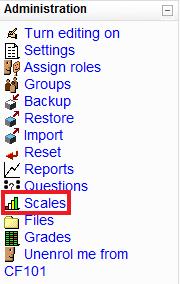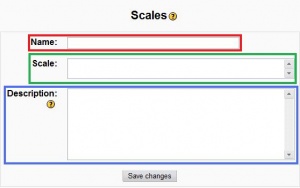Scales: Difference between revisions
(Edit for 1.9, reorganize, and reformat) |
|||
| Line 1: | Line 1: | ||
{{Course admin}} | {{Course admin}} | ||
[[Image:Scales_Icon.GIF]]Scales are a | [[Image:Scales_Icon.GIF]]Scales are a way of evaluating students' performance. Moodle offers a standard set of numeric scales. It is also possible to create custom scales which can be available on the site. For example, you can give the student a word or small phrase as a way of rating or giving a student feedback. | ||
Scales may be used in [[Forums]], [[Glossaries]] and [[Assignments]] for rating and/or grading a student's activity. | |||
==Standard scales== | |||
Moodle includes 100 different numeric scales which can not be edited, and one non-numeric example. | |||
===Numeric=== | |||
Moodle includes numeric scales that range from a maximum of 100 to a maximum of 1. For example, selecting a scale of 10, will allow a rating on a scale between 10 and 1. Numeric scales can be calculated as a [[Grades|grade]]. | |||
===Included non numeric scales=== | |||
Included in the standard 1.9 Moodle install is a scale called "Separate and Connected ways of knowing". This has 3 elements: "Mostly Separate Knowing", "Separate and Connected", "Mostly Connected Knowing". These phrases relate to a theory about how people approach the world. In edit mode, the teacher or administrator can see the scale description which explains the use of this interesting rating system. | |||
==Creating a new scale== | ==Creating a new scale== | ||
New scales can be created by teachers with editing rights or by administrators or by any user with the [[Capabilities/moodle/course:managescales|manage scales role capability]] (Moodle 1.7 onwards). The process is similar for making a new scale for either a course or site. | |||
===Creating course scales=== | |||
#Scales are located in the Grades in the course administration block. | |||
#For versions of Moodle prior to 1.9, click on the Scales link in the course [[Administration block]] (highlighted in red in the screenshot).[[Image:moodle19 adminbox scales.jpg|thumb|Moodle 1.8 course administration block]] In Moodle 1.9 onwards, click on the Grades link in the course Administration block, then select Scales from the Edit section of the grader report Choose an action dropdown list. | ##For versions of Moodle prior to 1.9, click on the Scales link in the course [[Administration block]] (highlighted in red in the screenshot).[[Image:moodle19 adminbox scales.jpg|thumb|Moodle 1.8 course administration block]] In Moodle 1.9 onwards, click on the Grades link in the course Administration block, then select Scales from the Edit section of the grader report Choose an action dropdown list. | ||
#On the Scales page click the "Add a new scale" button. | #On the Scales page click the "Add a new scale" button. | ||
#On the next page give your scale a name in the Name box (highlighted in red in the screenshot) that will identify it among other scales.[[Image:moodle19 scales edit.jpg| | #On the next page give your scale a name in the Name box (highlighted in red in the screenshot) that will identify it among other scales.[[Image:moodle19 scales edit.jpg|center|thumb|Creating a new scale screen: Name, Scale, Description areas]] | ||
#In the Scale box (highlighted in green), create your scale. Each item in the scale should be separated by a comma | #In the Scale box (highlighted in green), create your scale. Each item in the scale should be separated by a comma. You can use as many options here as you require. You must order the comma separated elements in increasing order of value. For example, an A,B,C,D scale must be entered as D,C,B,A. | ||
**For example, you could include a four option scale ''refer, pass, merit, distinction'' or ''Hesitant (Fail), Acceptable, Average, Excellent'' depending on your curriculum/course needs. | |||
#Write a detailed description in the Description box (highlighted in blue) for your scale. Your students will have access to the description, and you can use this to give them additional feedback. The more details you put in the description, the more students will understand what each scale item means. | #Write a detailed description in the Description box (highlighted in blue) for your scale. Your students will have access to the description, and you can use this to give them additional feedback. The more details you put in the description, the more students will understand what each scale item means. | ||
== | ===Creating a site scale=== | ||
Creating scales that are available in every course is similar to creating one for a single course. The site administrator will find a Scales link in the site administration block under Grades. It will list the scales available on the site, except the standard numeric sales. | |||
**In older versions of Moodle, Administrators has to create a site-wide scales by "promoting" a scale created for a course. To achieve this, add a new scale in any course, then use the move down arrow to move the scale from custom scales to standard scales (i.e. site-wide). | |||
==Using a scale== | |||
First the teacher needs to assign a specific scale to the activity using a drop down menu in the activities setting. Then the teacher and/or students can rate an activity element (for example, a post in a forum) with the pre-defined scale. | |||
==Editing a scale== | ==Editing a scale== | ||
A scale can only be edited if no activities are using that scale. If this is the case, you will see an Edit, move Down, and Delete icon in the edit column.[[Image:moodle19 scales edit buttons.jpg|Editing a scale]] | A scale can only be edited if no activities are using that scale. If this is the case, you will see an Edit, move Down, and Delete icon in the edit column.[[Image:moodle19 scales edit buttons.jpg|Editing a scale]] | ||
==Example scales== | ==Example scales== | ||
===The Cool Scale=== | |||
*''The Cool Scale'' - The coolest thing ever!, Very cool, Cool, Fairly cool, Not very cool, Not cool | *''The Cool Scale'' - The coolest thing ever!, Very cool, Cool, Fairly cool, Not very cool, Not cool | ||
===Affirmative Scale=== | |||
*''General Introductions (The Affirmative Scale)'' - Welcome!, Glad to have you here!, Great post! | *''General Introductions (The Affirmative Scale)'' - Welcome!, Glad to have you here!, Great post! | ||
===Complete=== | |||
If you would like two options in your scale (incomplete and complete) type "incomplete, complete" in the scale box. | |||
===Generic Social forum scale=== | |||
*''Generic Social Forum'' (This scale only worked prior to the averaging function) - Awesome!, Very cool., Interesting., Hmmm. Tell me more., I don’t understand. Please clarify. | *''Generic Social Forum'' (This scale only worked prior to the averaging function) - Awesome!, Very cool., Interesting., Hmmm. Tell me more., I don’t understand. Please clarify. | ||
== See also == | == See also == | ||
Revision as of 02:34, 18 July 2008
Scales are a way of evaluating students' performance. Moodle offers a standard set of numeric scales. It is also possible to create custom scales which can be available on the site. For example, you can give the student a word or small phrase as a way of rating or giving a student feedback.
Scales may be used in Forums, Glossaries and Assignments for rating and/or grading a student's activity.
Standard scales
Moodle includes 100 different numeric scales which can not be edited, and one non-numeric example.
Numeric
Moodle includes numeric scales that range from a maximum of 100 to a maximum of 1. For example, selecting a scale of 10, will allow a rating on a scale between 10 and 1. Numeric scales can be calculated as a grade.
Included non numeric scales
Included in the standard 1.9 Moodle install is a scale called "Separate and Connected ways of knowing". This has 3 elements: "Mostly Separate Knowing", "Separate and Connected", "Mostly Connected Knowing". These phrases relate to a theory about how people approach the world. In edit mode, the teacher or administrator can see the scale description which explains the use of this interesting rating system.
Creating a new scale
New scales can be created by teachers with editing rights or by administrators or by any user with the manage scales role capability (Moodle 1.7 onwards). The process is similar for making a new scale for either a course or site.
Creating course scales
- Scales are located in the Grades in the course administration block.
- For versions of Moodle prior to 1.9, click on the Scales link in the course Administration block (highlighted in red in the screenshot). In Moodle 1.9 onwards, click on the Grades link in the course Administration block, then select Scales from the Edit section of the grader report Choose an action dropdown list.
- On the Scales page click the "Add a new scale" button.
- On the next page give your scale a name in the Name box (highlighted in red in the screenshot) that will identify it among other scales.
- In the Scale box (highlighted in green), create your scale. Each item in the scale should be separated by a comma. You can use as many options here as you require. You must order the comma separated elements in increasing order of value. For example, an A,B,C,D scale must be entered as D,C,B,A.
- For example, you could include a four option scale refer, pass, merit, distinction or Hesitant (Fail), Acceptable, Average, Excellent depending on your curriculum/course needs.
- Write a detailed description in the Description box (highlighted in blue) for your scale. Your students will have access to the description, and you can use this to give them additional feedback. The more details you put in the description, the more students will understand what each scale item means.
Creating a site scale
Creating scales that are available in every course is similar to creating one for a single course. The site administrator will find a Scales link in the site administration block under Grades. It will list the scales available on the site, except the standard numeric sales.
- In older versions of Moodle, Administrators has to create a site-wide scales by "promoting" a scale created for a course. To achieve this, add a new scale in any course, then use the move down arrow to move the scale from custom scales to standard scales (i.e. site-wide).
Using a scale
First the teacher needs to assign a specific scale to the activity using a drop down menu in the activities setting. Then the teacher and/or students can rate an activity element (for example, a post in a forum) with the pre-defined scale.
Editing a scale
A scale can only be edited if no activities are using that scale. If this is the case, you will see an Edit, move Down, and Delete icon in the edit column.![]()
Example scales
The Cool Scale
- The Cool Scale - The coolest thing ever!, Very cool, Cool, Fairly cool, Not very cool, Not cool
Affirmative Scale
- General Introductions (The Affirmative Scale) - Welcome!, Glad to have you here!, Great post!
Complete
If you would like two options in your scale (incomplete and complete) type "incomplete, complete" in the scale box.
Generic Social forum scale
- Generic Social Forum (This scale only worked prior to the averaging function) - Awesome!, Very cool., Interesting., Hmmm. Tell me more., I don’t understand. Please clarify.
See also
- Using Moodle book Chapter 13: Grades and Scales

